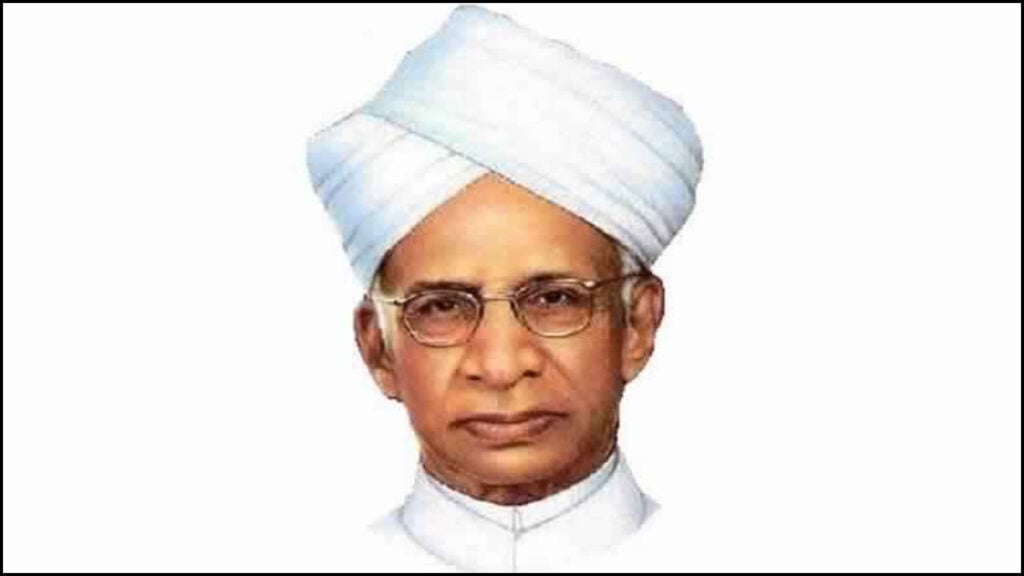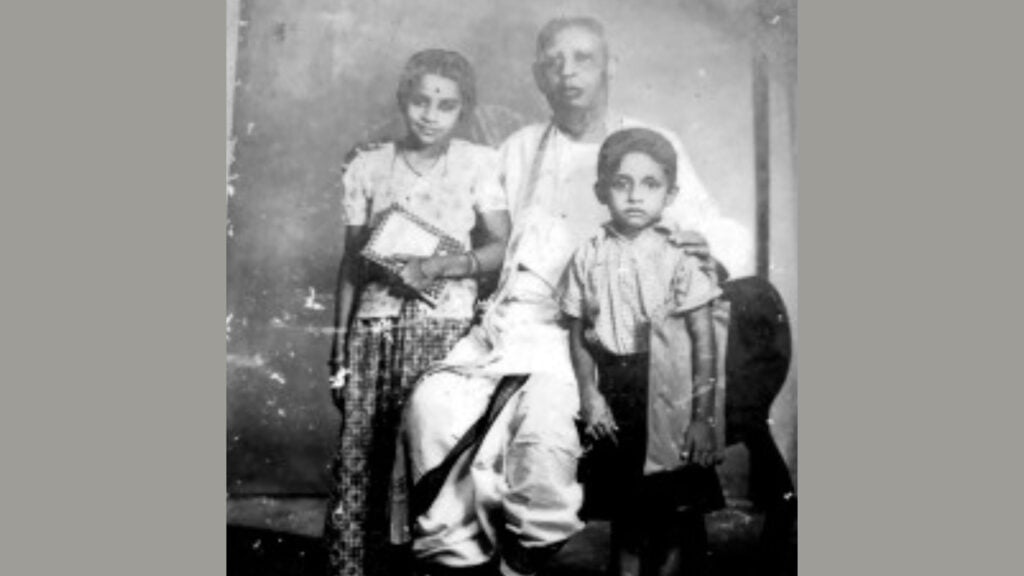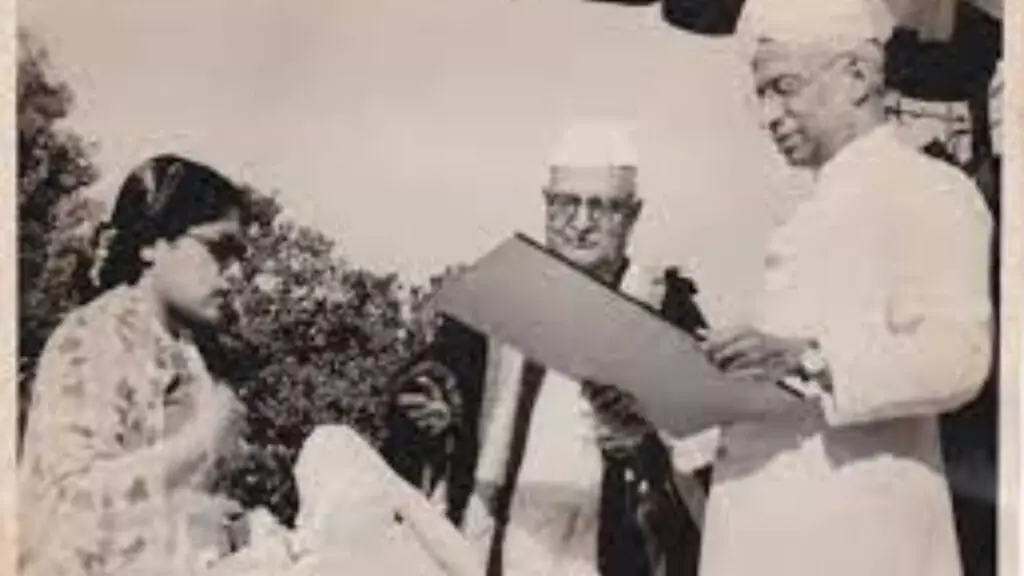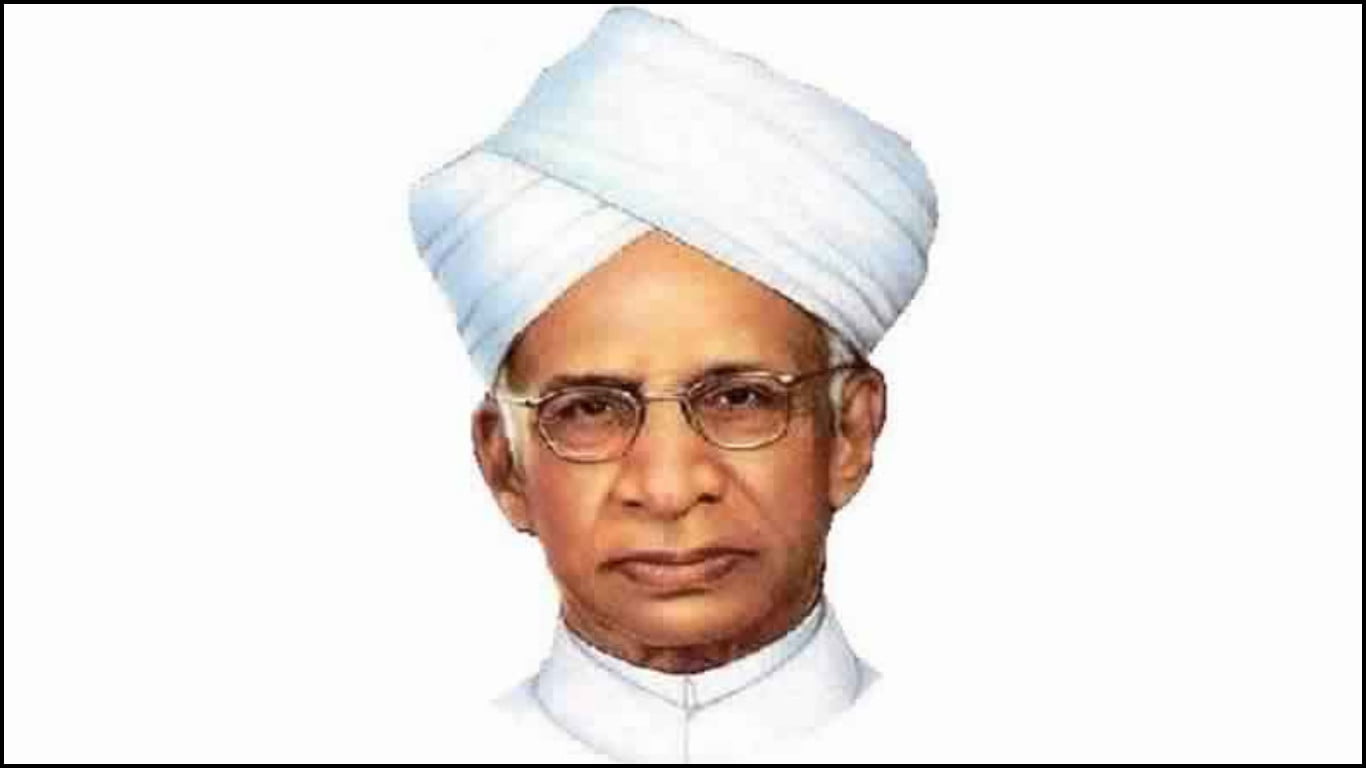Who was Dr. Sarvepalli Radhakrishnan?
Dr. Sarvepalli Radhakrishnan was an eminent Indian teacher, Hindu philosopher, scholar of philosophy, and a compassionate leader. He was the first Indian to be elected Vice President of independent India, whose tenure lasted from 1952 to 1962.
Dr. Sarvepalli Radhakrishnan was the second Indian to be elected President of India after Dr. Rajendra Prasad in 1962, whose tenure lasted from 1962 to 1967.
What is Sarvepalli Radhakrishnan most famous for?
Sarvepalli Radhakrishnan is known as a great teacher in India. For their important contribution in the field of education, 5 September has been celebrated as “Happy Teachers Day” every year in India since 1962. This is because he was born on this day. Although Teacher’s Day is celebrated all over the world on 5th October, in India it is celebrated a month before that.

Sarvepalli Radhakrishnan was honoured with the title of Knighthood in 1931 and after this in 1954 he was honoured with India’s highest civilian honour “Bharat Ratna”. In 1963, he was made an honorary member of the British Royal Order of Merit.
Physical Stats
| Full name: | Dr. Sarvepalli Radhakrishnan |
| Born: | 5 September 1888 , Tiruttani, Tamil Nadu, India |
| Died: | 17 April 1975 |
| Best Known For: | First Vice President of India and Second President of India |
| Education: | Doctorate in Philosophy, Oxford University (1916) |
| Age: | 86 Years |
| Profession: | Indian Politician, Teacher and Writer |
| Religion: | Hindu |
| Marital Status: | Married |
| Spouse: | Sivakamu (m.1903) |
| Children: | 1 Son Sarvepalli Gopal and 5 Daughter Padmavati, Rukmini, Sushila, Sundari and Shakuntala |
| Nationality: | Indian |
When and where was Dr. Sarvepalli Radhakrishnan born?
Dr. Sarvepalli Radhakrishnan was born on September 5, 1888 in Sarvepalli village of Andhra Pradesh, which at that time was the Madras Presidency of British India and is currently Tamil Nadu.

His grandfather had moved out of Sarvepalli and settled in Tiruttani, since then his family started living there.
Radhakrishnan was the second among three siblings. His father Sarvepalli Veeraswami was a subordinate revenue officer and his mother Sarvepalli Sita was a housewife.
What is Dr. Sarvepalli Radhakrishnan’s education background?
Radhakrishnan’s early education was from Tiruttani K.V. High school, from. He was a very bright student from childhood, due to which his father enrolled him in Hermannsburg Evangelical Lutheran Mission School, Tirupati in 1896, from where he completed his graduation.
Radhakrishnan graduated in philosophy from Madras Christian College in 1906 and earned a master’s degree in philosophy from the same college in 1908. After this he obtained a doctorate in philosophy from Oxford University in 1916.
When did Dr. Sarvepalli Radhakrishnan start his career?
Dr. Sarvepalli Radhakrishnan started his career as Professor of Philosophy at the University of Madras in 1909. He was appointed Professor of Philosophy at the Maharaja’s College, University of Mysore in 1918. Where he wrote his first novel “The Philosophy of Rabindranath Tagore”.

In 1921, Radhakrishnan was appointed Professor of Philosophy at the University of Calcutta, where he held the King George V Chair of Mental and Moral Sciences. He remained employed till 1932.
Meanwhile in 1931, George V knighted him for his services to education, and the Governor-General of India, the Earl of Willingdon, formally conferred his honour on him.
Radhakrishnan was the Vice Chancellor of Andhra University from 1931 to 1936. He was then elected a Fellow of All Souls College at the University of Oxford in 1936 and appointed Spalding Professor.
Radhakrishnan was elected Spalding Professor of Eastern Religions and Ethics at the University of Oxford in 1936.
Radhakrishnan served as the Vice Chancellor of Banaras Hindu University (BHU) from 1948 to 1949.
During his time at Oxford he became known as one of the leading scholars of comparative religion and philosophy. He introduced the whole world to Indian philosophy through his good thoughts, articles and speeches.
Beginning of Political Career
Dr. Sarvepalli Radhakrishnan‘s political career began in 1946 when he was appointed to the Constituent Assembly of India for the first time. During this period, after India’s independence, he remained involved in the political and cultural affairs of the country.

He was a member of the Constituent Assembly of India from 1946 to 1950, during which time he helped draft the Constitution of India and played an important role in the establishment of the UNESCO.
Radhakrishnan was appointed as India’s Ambassador to the Soviet Union in 1949, where he remained in Moscow until 1952.
How did Dr. Sarvepalli Radhakrishnan become the first Vice President and later President of India?
Dr. Sarvepalli Radhakrishnan was appointed as the first Vice President of India in 1952. He remained on this post till 1962. During this period, he played an important role in the functioning of the Rajya Sabha, contributing to the development of India’s parliamentary system.
He also played an important role in shaping the new nation and promoting the values of democracy and secularism. He is remembered as one of the most distinguished Vice Presidents of India.
In 1962, Dr. Sarvepalli Radhakrishnan was appointed to the highest constitutional post of President of India, where he remained till 1967. During this period, he made an important contribution in promoting education and culture in India.
He also played an important role in India’s foreign policy, especially relations with the Soviet Union and the United States.
As President, Radhakrishnan was known for his commitment to secularism and promoting religious tolerance.
When did Dr. Sarvepalli Radhakrishnan retire?
Dr. Sarvepalli Radhakrishnan retired from the post of President of India on May 13, 1967 at the age of 78.
He served two terms as President, the maximum period allowed by the Constitution. After his retirement, Radhakrishnan continued to write and lecture. He died on April 17, 1975 at the age of 86.
Radhakrishnan’s background was neither in the Congress Party nor was he active in the Indian independence movement, but he was a shadow politician.
His motivation lay in his pride in Hindu culture and his defence of Hinduism against “uninformed Western criticism”.
What did Dr. Sarvepalli Radhakrishnan do for India?
- Radhakrishnan promoted secularism and religious tolerance in India.
- He played an important role in India’s foreign policy, especially relations with the Soviet Union and the United States.
- He helped in improving the status of women in India.
- He promoted education and cultural development in India.
What are the achievements of Dr. Sarvepalli Radhakrishnan?
Sarvepalli Radhakrishnan was a renowned Indian philosopher, politician and educationist who was honoured with several achievements for his contributions to philosophy, education and international relations.
List of achievements
- Knighthood Awards: Radhakrishnan was honoured with the title of Knight in 1931, after which he came to be known as Sir Sarvepalli Radhakrishnan.
- Highest civilian award Bharat Ratna: Radhakrishnan was awarded India’s highest civilian award, Bharat Ratna, in 1954 for his distinguished service to the nation.
- Order of Merit: Radhakrishnan received the Order of Merit from the British Government in 1963.
- Peace Prize of the German Book Trade: In 1961, Radhakrishnan was awarded the Peace Prize of the German Book Trade for his efforts to promote peace and agreement between East and West.
- Templeton Prize: Radhakrishnan was posthumously awarded the “Templeton Prize” for progress in religion in 1975.
- Honorary Membership of the British Academy: Radhakrishnan was made an honorary member of the British Academy in 1938.
- Honorary Membership of the American Academy of Arts and Sciences: Radhakrishnan was elected an Honorary Fellow of the American Academy of Arts and Sciences in 1956.
- Honorary Membership of the USSR Academy of Sciences: Radhakrishnan was elected an honorary member of the USSR Academy of Sciences in 1952.
What was the name of Dr. Sarvepalli Radhakrishnan’s wife and how many children did he have?
Dr. Sarvepalli Radhakrishnan was married to her distant relative Sivakamu in May 1903, when she was 10 years old.
Radhakrishnan’s wife Sivakamu was a simple and religious woman. She was a great support to her husband throughout his career.
They had one son and five daughters named Sarvepalli Gopal (son), Padmavati, Rukmini, Sushila, Sundari and Shakuntala. Sarvepalli Gopal was a historian and writer. He also wrote a book on his father’s biography.
Radhakrishnan was a strict disciplinarian but he was also kind. He always encouraged his children to fulfil their dreams.
Who is the father of Teachers Day in India?
Dr. Sarvepalli Radhakrishnan is remembered as a great teacher in India. He was a brilliant scholar of philosophy. He was a strong supporter of education and social justice.

Teacher’s Day is celebrated every year in India on his birthday on 5 September for his important contribution in the field of education. On this day teachers are honoured with awards, speeches and other programs.
What are the famous books of Dr. Sarvepalli Radhakrishnan?
Radhakrishnan was a well-known and prolific writer who wrote more than 60 books on philosophy, religion and education. The list of top 20 most books written by him is given below.
- The Philosophy of Rabindranath Tagore (1918)
- The Reign of Religion in Contemporary Philosophy (1920)
- Indian Philosophy (1923)
- The Philosophy of the Upanishads (1924)
- The Philosophy of History (1926)
- The Hindu View of Life (1927)
- The Vedanta Philosophy and the Doctrine of Maya (1929)
- An Idealist View of Life (1932)
- Eastern Religions and Western Thought (1939)
- The Bhagavadgītā: With an Introductory Essay, Sanskrit Text, English Translation and Notes (1948)
- The Dhammapada: The Way of Truth (1950)
- The Philosophy of Dr. B.R. Ambedkar (1951)
- East and West: Some Reflections (1955)
- Recovery of Faith (1955)
- A Source Book in Indian Philosophy (1957)
- Living with a Purpose (1959)
- Mahatma Gandhi: Essays and Reflections on His Life and Work (1959)
- Is This Peace? (1966)
- Religion in a Changing World (1967)
- Religion, Science & Culture (1968)
What is Dr. Sarvepalli Radhakrishnan’s famous quotes about teachers?
- Dr. Sarvepalli Radhakrishnan has said that “True teachers are those who help us think for ourselves.”
- Dr. Sarvepalli Radhakrishnan has said that “Education is the most powerful weapon you can use to change the world.”
- Dr. Sarvepalli Radhakrishnan has said that “The teacher who is truly wise does not ask you to enter the house of his knowledge but takes you to the threshold of his mind.”
- Dr. Sarvepalli Radhakrishnan has said that “Books are the means by which we build bridges between cultures.”
- Dr. Sarvepalli Radhakrishnan has said that “Teachers should have the best minds in the country.”
Conclusion
Overall, Dr. Sarvepalli Radhakrishnan was one of the most famous and prominent Indian thinkers of the twentieth century, who during his forty years of academic career not only won the hearts of Indians with his lectures in the famous universities of the country, but also through his teachings in the countries of Western civilization. Enthralled people with unique ideas. He is known less as a leader and more as a teacher.
FAQs
1. When was Dr. Sarvepalli Radhakrishnan born?
Answer: September 5, 1888
2. Where was he born?.
Answer: Tiruttani, Tamil Nadu, India
3. What was his field of study?
Answer: Philosopher and Scholar
4. What was his highest academic qualification?
Answer: Doctor of Philosophy (PhD)
5. Which universities did he teach at?
Answer: University of Mysore, University of Calcutta, and University of Oxford
6. What was his political career?
Answer: The Second President of India from 1962 to 1967
7. What was his most famous book?
Answer: “The Hindu View of Life”
8. What are some of his major works?
Answer: The Hindu View of Life, Eastern Religions and Western Thought, The Philosophy of Rabindranath Tagore, The Bhagavad Gita: The Song of God
9. What were his awards and honors?
Answer: He was awarded the Bharat Ratna, India’s highest civilian award, in 1954. He was also awarded the Templeton Prize, a prize for progress in religion, in 1975.
10. What were his contributions to education?
Answer: He was a strong advocate for education and believed that it was the key to India’s progress. He served as the Vice-Chancellor of the University of Delhi and the University of Madras.


Web Development Wizards https://zetds.seychellesyoga.com/info
Can provide a link mass to your website https://zetds.seychellesyoga.com/info
Your site’s position in the search results https://zetds.seychellesyoga.com/info
Free analysis of your website https://zetds.seychellesyoga.com/info
SEO Optimizers Team https://zetds.seychellesyoga.com/info
I offer mutually beneficial cooperation https://zetds.seychellesyoga.com/info
Cool website. There is a suggestion https://zetds.seychellesyoga.com/info
I really liked your site. Do you mind https://zetds.seychellesyoga.com/info
Here’s what I can offer for the near future https://zetds.seychellesyoga.com/info
You will definitely like it https://zetds.seychellesyoga.com/info
Content for your website https://ztd.bardou.online/adm
Web Development Wizards https://ztd.bardou.online/adm
Can provide a link mass to your website https://ztd.bardou.online/adm
Your site’s position in the search results https://ztd.bardou.online/adm
Free analysis of your website https://ztd.bardou.online/adm
SEO Optimizers Team https://ztd.bardou.online/adm
I offer mutually beneficial cooperation https://ztd.bardou.online/adm
Cool website. There is a suggestion https://ztd.bardou.online/adm
I really liked your site. Do you mind https://ztd.bardou.online/adm
Here’s what I can offer for the near future https://ztd.bardou.online/adm
Content for your website https://ztd.bardou.online/adm
Web Development Wizards https://ztd.bardou.online/adm
Can provide a link mass to your website https://ztd.bardou.online/adm
Your site’s position in the search results https://ztd.bardou.online/adm
Free analysis of your website https://ztd.bardou.online/adm
SEO Optimizers Team https://ztd.bardou.online/adm
I offer mutually beneficial cooperation https://ztd.bardou.online/adm
Cool website. There is a suggestion https://ztd.bardou.online/adm
Content for your website http://myngirls.online/
Web Development Wizards http://myngirls.online/
Can provide a link mass to your website http://myngirls.online/
Your site’s position in the search results http://myngirls.online/
Free analysis of your website http://myngirls.online/
SEO Optimizers Team http://myngirls.online/
I offer mutually beneficial cooperation http://myngirls.online/
Content for your website http://fertus.shop/info/
Web Development Wizards http://fertus.shop/info/
Can provide a link mass to your website http://fertus.shop/info/
Your site’s position in the search results http://fertus.shop/info/
Free analysis of your website http://fertus.shop/info/
SEO Optimizers Team http://fertus.shop/info/
I offer mutually beneficial cooperation http://fertus.shop/info/
Cool website. There is a suggestion http://fertus.shop/info/
I really liked your site. Do you mind http://fertus.shop/info/
Dear readers Thanks for your compliments
Here’s what I can offer for the near future http://fertus.shop/info/
You will definitely like it http://fertus.shop/info/
The best prices from the best providers http://fertus.shop/info/
Additional earnings on your website http://fertus.shop/info/
Analytics of your website http://fertus.shop/info/
I would like to post an article http://fertus.shop/info/
How to contact the administrator on this issue http://fertus.shop/info/
Shall we exchange links? My website http://fertus.shop/info/
The offer is still valid. Details http://fertus.shop/info/
We offer cooperation on SEO optimization http://fertus.shop/info/
Content for your website http://fertus.shop/info/
Web Development Wizards http://fertus.shop/info/
Your site’s position in the search results http://fertus.shop/info/
Content for your website http://fertus.shop/info/
Can provide a link mass to your website http://fertus.shop/info/
Free analysis of your website http://fertus.shop/info/
Excellent write-up
Excellent write-up
Thank you
Excellent write-up
great article
What a great read! The humor was a nice touch. For further details, click here: READ MORE. Let’s chat about it!